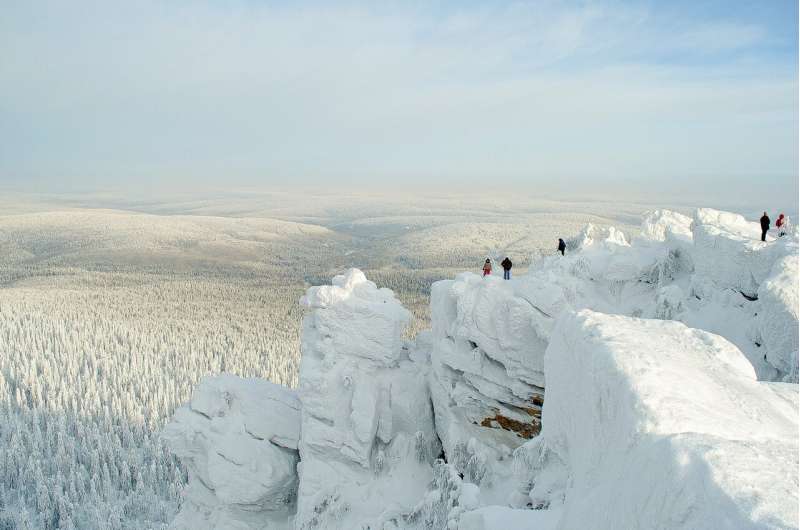Credit: Pixabay/CC0 Public Domain
Climate change is altering weather patterns, making it increasingly difficult to accurately predict extreme cold weather events in the short term.
A group of leading meteorologists recently determined that an important physical factor, the meridional potential vorticity gradient (PVy), was abnormally weak during the extreme cold weather events experienced simultaneously in East Asia and North America in November and December 2022. The team predicts that more accurate PVy modeling may improve forecasting of extreme cold weather events and future climate conditions.
The research team analyzed the atmospheric circulation that occurred during the frequent bouts of extreme cold experienced in the middle latitudes of the Northern Hemisphere in both East Asia and North America between November and December of 2022. The team found that, in both East Asia and North America, large, stationary blocking weather patterns prevented other weather systems from moving through, perpetuating the cold weather in both locations.
Further analysis revealed that the PVy, a meridional gradient of potential vorticity in the atmosphere, was unusually weak during this time, and likely contributed to the prolonged cold weather and associated snow events observed in these regions.
The research team reported their results in Advances in Atmospheric Science on February 9.
"In our previous study, we found that frequent cold waves were more likely to occur in mid-latitude Asia in the upcoming 2022-2023 winter season under the background of a warm Arctic and a cold tropical Pacific. In our current study, we wanted to know what actually caused these cold surges and if the cold events in North America and East Asia were related," said Yao Yao, lead author of the research study and associate professor at the Chinese Academy of Sciences (CAS) Key Laboratory of Regional Climate-Environment for Temperate East Asia in the CAS Institute of Atmospheric Physics (IAP).
The research team's November 2022 prediction proved correct, as extreme cold events have been frequent in the middle latitudes in Asia for at least the first half of the 2022-2023 winter season. Further analysis in the current study additionally revealed a weak connection between the extreme cold event experienced in East Asia around November 26, 2022 and the cooling with tornadic outbreaks and "bomb cyclone" observed in North America in mid- and late December 2022, respectively.
The unusually weak potential vorticity gradient of the middle-latitude Northern Hemisphere atmosphere during this timeframe facilitated the development of stationary blocking weather patterns in both the Ural Mountains and Alaska, causing the frequent extreme cold weather and snowstorm events in East Asia and North America, respectively.
Abnormally weak atmospheric meridional potential vorticity gradients not only create favorable conditions for blocking weather patterns, but also decrease their predictability. "As a result, the difficulty of predicting cold extremes increases," said Dehai Luo, co-author of the research paper and professor at the CAS Key Laboratory of Regional Climate-Environment for Temperate East Asia in the CAS IAP. Existing models are simply less effective at accurately predicting the movement of blocking weather patterns when potential vorticity gradients are so low.
"Low Arctic sea ice and La Niña favor the reduction of mid-latitude potential vorticity gradients, but there are many other factors affecting this gradient. The next step is to identify these factors and try to establish a relatively sound statistical model, which is important for short-term weather and climate prediction," Yao said.
Once these factors are determined through future study, blocking weather pattern predictability will increase. "Such a study will likely improve the prediction of winter cold extremes," Luo said. Ideally, improved forecasting will decrease the often devastating economic losses and casualties that can occur with unexpected cold snaps.
More information: Yao Yao et al, Extreme Cold Events in North America and Eurasia in November−December 2022: A Potential Vorticity Gradient Perspective, Advances in Atmospheric Sciences (2023). DOI: 10.1007/s00376-023-2384-3. link.springer.com/article/10.1 … 07/s00376-023-2384-3
Fei Zheng et al, Can Eurasia Experience a Cold Winter under a Third-Year La Niña in 2022/23?, Advances in Atmospheric Sciences (2022). DOI: 10.1007/s00376-022-2331-8
Journal information: Advances in Atmospheric Sciences
Provided by Chinese Academy of Sciences
























